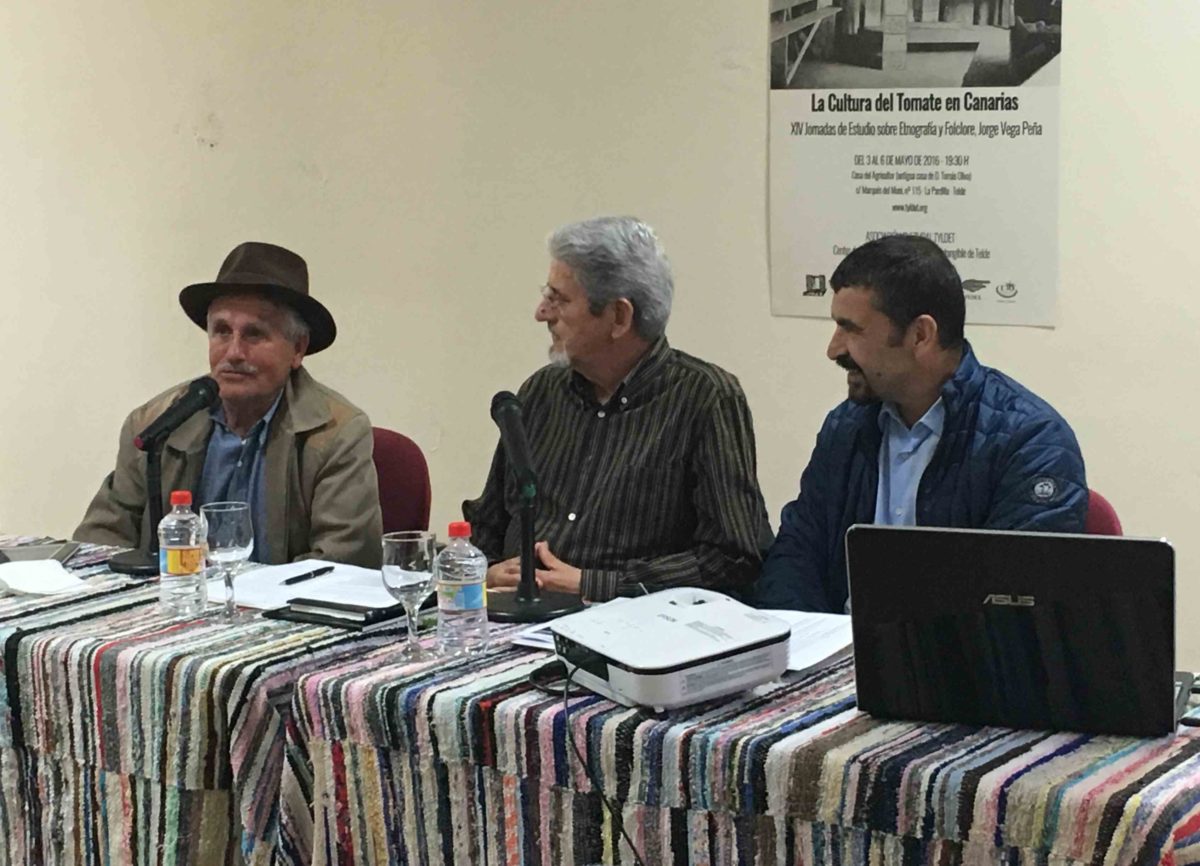 For four intense days, the XIV Conference of ethnography and folklore study, Jorge Vega Peña, They addressed the culture of tomato in Canary from various perspectives.
For four intense days, the XIV Conference of ethnography and folklore study, Jorge Vega Peña, They addressed the culture of tomato in Canary from various perspectives.
Organized by the Tyldet Cultural Association, the Conference on Culture of tomato in the Canary Islands have been an important milestone in the events celebrating this partnership comes in the last fifteen years.
It all started, recalls the president of Tyldet, Miguel Vega, when do we start, during the month of July 2015, the digitization of photographic archive retired photographer teldense, Jose Hernandez Torres.
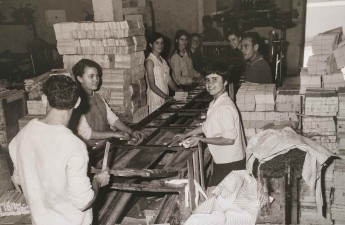 Photographed negative after negative starting with the year 1965 and reaching 1970. In total, They were digitalized 613 Rolls of 35 mm, involving 17.637 negative. The scan job lasted until January, and we did just "tickle" the photographic background, Vega explains.
Photographed negative after negative starting with the year 1965 and reaching 1970. In total, They were digitalized 613 Rolls of 35 mm, involving 17.637 negative. The scan job lasted until January, and we did just "tickle" the photographic background, Vega explains.
During subsequent sessions he observed that there was a topic of great interest appeared frequently: pictures taken on tomatoes stores. Hernandez told us that for years traveled regularly to various stores of the municipality of Telde, to photograph staff, mainly in their rest time after lunch, Miguel Vega indicates.
Of total images, 1.437 correspond to this subject. Given that during 2015 they had fulfilled 130 Tomato export years in the Canary Islands, whose principles are precisely in Telde, the subject of the exhibition arose spontaneously and, from there, object Days.
Exposure 'Between Tomatoes', which will be open until next day 30 may, comprises 48 printed photos, divided into three sections: "Crops and sharecropping", "Racking truck 'and' Entre boxes and seretos"; and is accompanied by a video projection on many other images considered of interest.
With this exhibition, Vega says, we wanted to make public recognition to D. Jose Hernandez Torres, whose work has left images captured in an important part of the history of our people.
The days
Complementing exposure coinciding with the 130 Anniversary activity Canary tomato exports, we decided to dedicate the XIV Conference of the Association address the culture of tomato in the Canary Islands from various perspectives and with some of its protagonists, Miguel Vega indicates.
 The first speaker of the XIV Conference on Ethnography and Folklore, Jorge Vega Peña, It was the historian Manuel Rebollo Lopez said: “Telde's contribution to the culture of tomato was important ". The business of tomato and shipment to European territories began to develop in Gran Canaria in the late nineteenth century, specifically in 1885.
The first speaker of the XIV Conference on Ethnography and Folklore, Jorge Vega Peña, It was the historian Manuel Rebollo Lopez said: “Telde's contribution to the culture of tomato was important ". The business of tomato and shipment to European territories began to develop in Gran Canaria in the late nineteenth century, specifically in 1885.
Rebollo recalled that the activity began only the British who traded his country, but whose witness took the canaries time entrepreneurs who were eager, to ensure their interests, to settle in UK, first, and also in the Netherlands, later.
“an exporter, however small, produced its tomatoes, He took care of shipment by sea and even to sell himself on arrival”, so that in times past there came to be “more than seventy representatives in London or Rotterdam” Harvesters working for islanders, researcher Manuel Rebollo told.
Exporter of Telde, Carmelo Santana Peña, He presented his experiences as a receiver and fruit seller in the London markets, mainly in Covent Garden, where there were nearly a hundred businesses dedicated to the sale of tomato and cucumber canaries. Santana referred the imprint left by the canaries in this part of the city, like the famous Canary Wharf today become the largest business district of the City.
Santana said in his speech that "the export of tomatoes was the largest source of income, not only the municipality of Telde but also of the whole island in the early 60 the twentieth century ".
The exporter recalled the names of other exporters operating in the same time, as Joseph and Daniel Betancor Herrera, José López Valerón, Isidro Morales Morales, Antonio Benitez Galindo, Valido brothers DIEPA, José Monzón, Juan Monzon Santana, Don Manuel Ruiz, Tomas Oliva Chil, Mayor Juan Manuel Martin and his brothers, Francisco and Jose, Juan and Francisco Rivero, Francisco Calderín and my father Jose Santana, better known as Navarro ".
The major shipping companies in those years were the Aznar shipping company with vessels Monte Ulia, Monte Urquiola and Mount Hope; Fred Olsen Line and their boats Brunos and Bencomo. The boats took five or six days and the fruit was stacked in warehouses lacking air conditioning. Docks destination was Canary Wharf and New Fresh Wharf.
"During the decade of the 60 the city of Telde was the engine of the Canarian economy. To such an extent, a local bank received more foreign currency in six months, pounds, Dutch guilders or DM, its headquarters in Las Palmas throughout the year, Santana said.
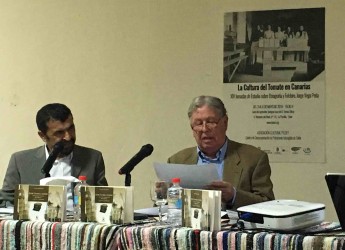 Our tomatoes are not only distributed in all cities in England, but throughout Scotland Inverness and Aberdeen reaching. Although, no doubt, England has always been our main consumer, coming to claim the 60% tomato produced in the islands. Many of you will wonder how such consumption in a country with such low temperatures possible, but the explanation is simple, especially if we consider facts like that the typical English breakfast consists of fried egg, bacon and two fried tomatoes. In addition, the British love the tomato soup ", Carmelo Santana explained, who lived in London 30 years that was devoted to the reception and marketing of Canary tomatoes.
Our tomatoes are not only distributed in all cities in England, but throughout Scotland Inverness and Aberdeen reaching. Although, no doubt, England has always been our main consumer, coming to claim the 60% tomato produced in the islands. Many of you will wonder how such consumption in a country with such low temperatures possible, but the explanation is simple, especially if we consider facts like that the typical English breakfast consists of fried egg, bacon and two fried tomatoes. In addition, the British love the tomato soup ", Carmelo Santana explained, who lived in London 30 years that was devoted to the reception and marketing of Canary tomatoes.
In the third session intervened social worker and priest, Sunday Viera and the sharecropper and leader of the trade union struggle, José Luis Pérez Ojeda.
Viera began his presentation with a brief biographical sketch of the time when he was in the southeast of Gran Canaria, Castillo del Romeral and Juan Grande, What He focused on another fight, the schools and kindergartens in sharecropping.
A 14 in January of 1975, after a meeting, They cut the road for hours south to demand that did. The Matorral got it after signing, that commitment, the mayor upon the altar of the church of Juan Grande. A giant step in claiming culture and education.
José Luis Pérez Ojeda previously excused his narrative disorder because of their 83 years. However, lucidity and clarity of argument were the opposite.
José Luis began his speech by recalling the historical labor lawyer Carlos Suarez Cabrera, also it is known as 'the black whip', which had much of the achievements of the struggle sharecropper, and his companion Celedonio, 'Ninth'.
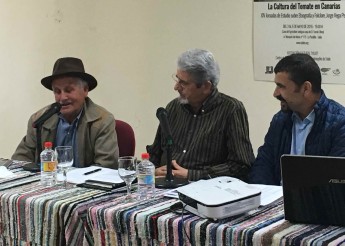 A fight, recalled, He began in the late sixties and managed some of their demands in the early seventies, with a mandatory standard which improved working conditions. It was achieved by 400 workers who moved to the capital of Gran Canaria and then took the vertical union. They did not achieve the same rights as other sectors, but a breakthrough.
A fight, recalled, He began in the late sixties and managed some of their demands in the early seventies, with a mandatory standard which improved working conditions. It was achieved by 400 workers who moved to the capital of Gran Canaria and then took the vertical union. They did not achieve the same rights as other sectors, but a breakthrough.
Pérez recalled the appalling living conditions, but also exploitation, for both men and women, In addition to the health risks of chemicals that were used.
José Luis concluded by explaining that, despite the struggles of workers so many decades ago, today there are sectors that have regressed rights. "The hotel industry is now worse off than they were sharecroppers', with the seriousness that there is less class consciousness and separatism, he explained. "Now there are more sheep and more ignorant people more studies', he sentenced.
In the second presentation of this session, the degree and a doctorate in Geography and History from the UNED; Associate professor at the UNED Center in Las Palmas de G.C. and researcher, Manuel Ramírez Muñoz spoke about the frequent arrivals to the island of berberisco Cigarrón and constant threat to agriculture.
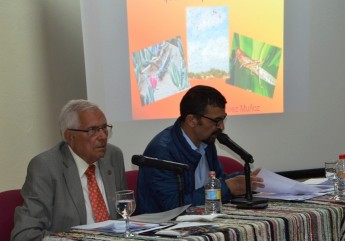 Ramirez addressed four great plagues of berberisco Cigarrón that devastated the Canary Islands last century. The most serious, by destructions in agriculture, was that of 1954. In that year, a testimony owner of a farm of bananas, collected in the Diario de las Palmas, recounts the materials used to combat locust infestation. "I burned about twelve thousand kilos of straw feed, five thousand liters of diesel, five hundred and sixty dozens of flying, seven kilos sulfur, fifty kilos of sulfurol, seven or eight car tires and all the leaves that had prepared for packing bunches of bananas for export '.
Ramirez addressed four great plagues of berberisco Cigarrón that devastated the Canary Islands last century. The most serious, by destructions in agriculture, was that of 1954. In that year, a testimony owner of a farm of bananas, collected in the Diario de las Palmas, recounts the materials used to combat locust infestation. "I burned about twelve thousand kilos of straw feed, five thousand liters of diesel, five hundred and sixty dozens of flying, seven kilos sulfur, fifty kilos of sulfurol, seven or eight car tires and all the leaves that had prepared for packing bunches of bananas for export '.
Ultimately, Ramirez said, he attended church: prayers, prayers, exorcisms or the landlady in procession to the cathedral.
Muñoz Ramírez recalled that residents of Cercados Spider, in Gran Canaria, once refused to cooperate in the work of extinction saying that "as God's punishment, They should and can only extinguish the priests with their exorcisms ".
From the relentless plague 1954, a new tactic began, that of chemical control. This was the definitive method that got, at least, stand up to the insatiable enemy. In 1988, amid a wave of lobster on Canary, an article in ABC says Antonio Cruz: “The Ministry has set all devices to address the plague, and a helicopter flies over the entire strip southeast of the island to perform fumigations”.
The last day of the conference began with the presentation of the writer and technician Culture, Pedro Franco López, who he spoke on "Tomatoes and Tourism".
The writer sketched his childhood around tomato crops in the south of the island and told how the activity transformed the geography of this area of Gran Canaria.
 Parallel to the tomato crop, While tourists began arriving in the early twentieth century, from years 60 the last century was when he blunted the tourism industry that brought about the building needed a significant labor.
Parallel to the tomato crop, While tourists began arriving in the early twentieth century, from years 60 the last century was when he blunted the tourism industry that brought about the building needed a significant labor.
At this time there was a major battle between tomato and tourism which led to the loss of labor the first for the second, It is offering better conditions and the possibility of continuing in the services, He explained Pedro Franco.
The last presentation was given by Dr. Rosa Maria Henriquez Sociology Rodríguez, which he made an approach to the participation of women in tomato cultivation in sharecropping.
Sharecropping contracts linked to not only hired but the whole family, although, legally, considering only workers who had signed, usually the head of household. However, women assumed much of the crop daily duties without labor rights, said Henríquez.
Being a family work, besides women children, from the greatest to the smallest, They had to contribute in cultivating the extent possible, especially tying and picking tomatoes.
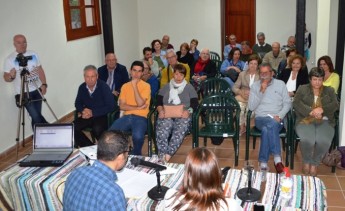 In the decade of the 80 Last century saw a remarkable change to make women appear as partners in contracts, can replace the 'official' worker in the event of death or disability, said Rosa Maria.
In the decade of the 80 Last century saw a remarkable change to make women appear as partners in contracts, can replace the 'official' worker in the event of death or disability, said Rosa Maria.
In the decade of the 90 there was another transformation, women appearing as contract holders, coming to represent the 75% of labor as holders.
When the tomato crop was done with laborers, fundamentally Women were required, among other things also because his salary was different, They were paid less than men, so the labor was much cheaper; something that has not changed much concluded Henriquez.
New Farmer House, located in the former home of Thomas Oliva in La Pardilla, was the scene of the conference ended with a tasting of Canarian tomatoes provided by FEDEX and performance of revelry The Cerrillal.

